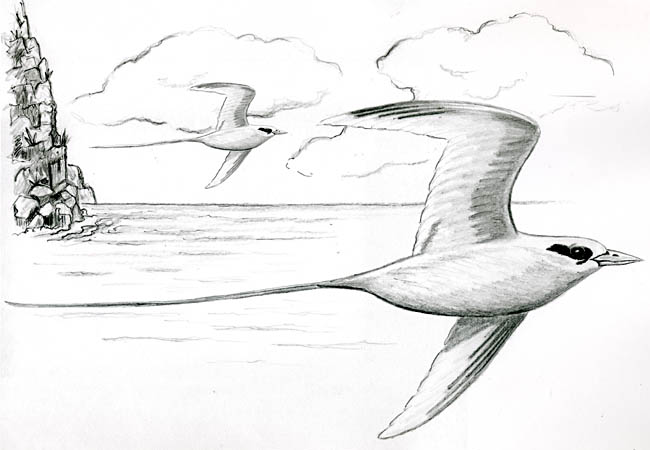
Dear Bird Folks,
Last spring I spent a week in Bermuda. Like most tourists I spent much of my time shopping. Just about every shop I visited sold necklaces with a bird called a “longtail” hanging from them. I even bought one for myself. Now I’m afraid to wear it because I’m not even sure if it’s really a bird, since there is no longtail in any of my bird books. Is there really such a bird or is it something the locals invented to con the gullible tourists?
– Rachel, Natick, MA
You’re a victim, Rachel,
You are a victim of what one of my fellow workers refers to as the “Tupperware syndrome.” You bought something just because it seemed like the thing to do at the time. We all do it. I once bought a Hawaiian shirt on my trip to Honolulu. Yes, a Hawaiian shirt. I don’t know what I was thinking. Was I suddenly going to become Cape Cod’s answer to Don Ho or get a night job at Trader Joe’s? At least you only bought an inconspicuous necklace. What I bought makes me look like a walking fruit bowl. Next time I’ll take a cue from you and will get a necklace instead. Then I’ll be Cape Cod’s answer to Mr. T, which I kind of am anyhow.
You may have gotten caught up in the moment, Rachel, but you didn’t buy an image of a bird that was invented by the locals, only the name was invented. “Longtail” is Bermuda’s name for the White-tailed Tropicbird, a bird that is beautiful whether it’s in the wild or on a necklace. Look up White-tailed Tropicbird in your bird book and you’ll find it. If you don’t see tropicbird in your book then you need to get yourself a new, adult book. I mean, a bird book that’s complete and written for adults, not the kind of book found in adult bookstores. Those books have way too much molting going on.
As the name suggests, the White-tailed Tropicbird is a bird that pretty much sticks to the tropics. It’s also a staunch seabird, so the tropics in this case are the maritime tropics. It won’t be found in the tropical rainforests, not even on vacation.
Although tropicbirds typically avoid land, each year hundreds come to Bermuda to breed. Most people visit Bermuda for its beaches, but the birds go there for its less-famous limestone cliffs. Much of Bermuda is made of limestone and that’s what the birds like. The soft limestone is riddled with holes and crevices, which is perfect for the tropicbirds’ nesting needs. A cliffside dwelling is important for tropicbirds, because, even though they are masters of the air, they stink at walking. If they have to move on land, even a little, they must slide all on their bellies, pushing with their feet, while pulling themselves with their bills, looking like passengers returning to their cruise ship after an all night party.
One look at this bird and you can easily see why the Bermudians call it the “longtail.” At first glance the tropicbird appears to be a large tern, except this tern has sixteen-inch tail feathers trailing behind it. Soaring above the dramatic cliffs, with Bermuda’s blue water in the background, the bright white bird with the long flowing tail draws the attention of everyone, whether they’re interested in birds or not.
For years the White-tailed Tropicbirds were abused on their Bermuda nesting grounds, but slowly the locals have changed their evil ways. Development and access to the sensitive nesting areas have been restricted. Now the tropicbird is not only protected, but it is the official national bird of Bermuda, with its image depicted on postage stamps and coins. By cashing in on the bird’s notoriety, the island has used its image to draw tourists, and merchants have made bags of money selling a whole host of longtail-related items, including necklaces. One might actually draw a comparison between Bermuda’s successful marketing of the White-tail Tropicbird and the continued lost opportunity to promote of Cape Cod’s specialty bird, the Piping Plover. Around here everyone curses plovers instead of promoting them, leaving me the only one making money off them, which if fine with me.
The warm waters of the tropics are clean, clear and great for snorkeling; but because they are so clear, they are not particularly rich in food. The birds must constantly travel in order to find enough to eat. The tropicbird’s food of choice is flying fish. (Apparently flying fish are real. Who knew?) If the fish are just below the surface the birds use shallow dives to grab their meals. But if the flying fish are out of the water and actually “flying,” which they do to avoid aquatic predators, the birds will hover above the surface and pick them off in the air like flycatchers grabbing insects. Tropicbirds may not be the best walkers in world, but they can totally take care of things in the air.
Longtails/tropicbirds are definitely real, Rachel. And very beautiful too, I might add. You can wear your necklace with pride. As for my Hawaiian shirt, it’s been in the same package since the day I bought it, and that was twenty-two years ago. I think that’s where it’s going to stay for the next twenty-two years, unless that night job at Trader Joe’s finally opens up.